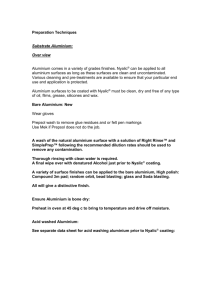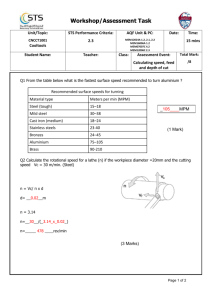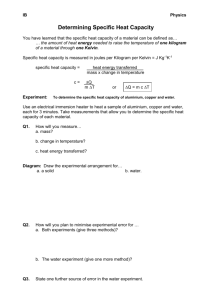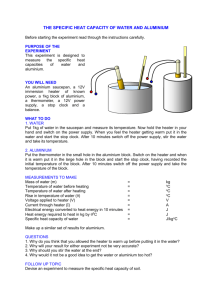AMPHOTERIC ALUMINIUM Introduction Whilst aluminium is mostly
advertisement
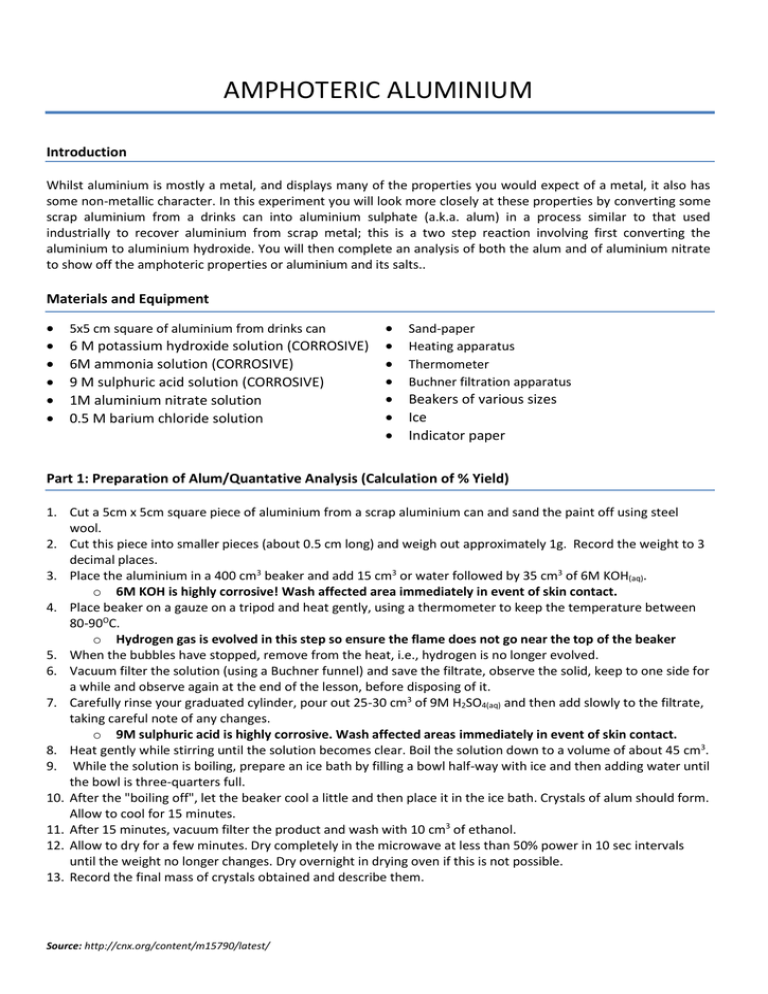
AMPHOTERIC ALUMINIUM Introduction Whilst aluminium is mostly a metal, and displays many of the properties you would expect of a metal, it also has some non-metallic character. In this experiment you will look more closely at these properties by converting some scrap aluminium from a drinks can into aluminium sulphate (a.k.a. alum) in a process similar to that used industrially to recover aluminium from scrap metal; this is a two step reaction involving first converting the aluminium to aluminium hydroxide. You will then complete an analysis of both the alum and of aluminium nitrate to show off the amphoteric properties or aluminium and its salts.. Materials and Equipment 5x5 cm square of aluminium from drinks can 6 M potassium hydroxide solution (CORROSIVE) 6M ammonia solution (CORROSIVE) 9 M sulphuric acid solution (CORROSIVE) 1M aluminium nitrate solution 0.5 M barium chloride solution Sand-paper Heating apparatus Thermometer Buchner filtration apparatus Beakers of various sizes Ice Indicator paper Part 1: Preparation of Alum/Quantative Analysis (Calculation of % Yield) 1. Cut a 5cm x 5cm square piece of aluminium from a scrap aluminium can and sand the paint off using steel wool. 2. Cut this piece into smaller pieces (about 0.5 cm long) and weigh out approximately 1g. Record the weight to 3 decimal places. 3. Place the aluminium in a 400 cm3 beaker and add 15 cm3 or water followed by 35 cm3 of 6M KOH(aq). o 6M KOH is highly corrosive! Wash affected area immediately in event of skin contact. 4. Place beaker on a gauze on a tripod and heat gently, using a thermometer to keep the temperature between 80-90OC. o Hydrogen gas is evolved in this step so ensure the flame does not go near the top of the beaker 5. When the bubbles have stopped, remove from the heat, i.e., hydrogen is no longer evolved. 6. Vacuum filter the solution (using a Buchner funnel) and save the filtrate, observe the solid, keep to one side for a while and observe again at the end of the lesson, before disposing of it. 7. Carefully rinse your graduated cylinder, pour out 25-30 cm3 of 9M H2SO4(aq) and then add slowly to the filtrate, taking careful note of any changes. o 9M sulphuric acid is highly corrosive. Wash affected areas immediately in event of skin contact. 8. Heat gently while stirring until the solution becomes clear. Boil the solution down to a volume of about 45 cm3. 9. While the solution is boiling, prepare an ice bath by filling a bowl half-way with ice and then adding water until the bowl is three-quarters full. 10. After the "boiling off", let the beaker cool a little and then place it in the ice bath. Crystals of alum should form. Allow to cool for 15 minutes. 11. After 15 minutes, vacuum filter the product and wash with 10 cm3 of ethanol. 12. Allow to dry for a few minutes. Dry completely in the microwave at less than 50% power in 10 sec intervals until the weight no longer changes. Dry overnight in drying oven if this is not possible. 13. Record the final mass of crystals obtained and describe them. Source: http://cnx.org/content/m15790/latest/ Part 2: Qualitative Analysis of Alum 1. Test the solubility, acidity and reaction with barium chloride: o Use a spatula to transfer a few of the alum crystals (about 5 mg) to a watch glass. Add 3 drops of water to the crystals. Stir gently until the crystals dissolve. o Use a small piece of indicator paper to see whether the solution is acidic, basic, or neutral. o Now add 1 drop of 0.5 M BaCl2 (barium chloride) to the solution. Record your observations. 2. Conduct a flame-test on the alum o A really good test for the presence of potassium is a flame test. Using test-tube tongs, hold a stainless spatula in the flame of a Bunsen burner to remove impurities from the spatula. o When one end of the spatula is red hot, remove it, and quickly touch it to a small cluster of crystals. Several should stick. o Slowly bring the spatula (plus crystals) toward the flame and watch carefully. Hold the crystals in the flame for at least 5 seconds (until the solid glows). Record your observations. o Remove the spatula and place on a heat-proof mat. Part 3: Acid-Base Properties of Aluminium Compounds 1. Clean 3 test-tubes and label them 1 to 3. 2. Tube 1: Place 10 drops of 1M aluminium nitrate solution and 2 drops of 6.0 M sodium hydroxide solution, mix well and record your observations on your lab report Then add more sodium hydroxide solution to tube 1 until a reaction is observed (around 7 drops). Mix well. Record your observations. 3. Tube 2: Place 10 drops of 1M aluminium nitrate solution and 2 drops of 6.0 M potassium hydroxide solution, mix well and record your observations on your lab report Then add 4 cm3of 6M HCl and record your observations. 4. Tube 3: Add 3 cm3 of 6M ammonium hydroxide, i.e aqueous ammonia to some of your alum and record your observations. Analysis Part 1: o Write balanced equations to describe the two steps in the reaction (try to do this without resorting to textbooks or the interweb. o Calculate the % yield you obtained. o Explain how this experiment shows off the amphoteric properties of alumnium. Part 2: o Explain all observations using equations where relevant. Part 3: o Explain all of your observations, explaining how they demonstrate aluminium’s amphoteric behaviour. Source: http://cnx.org/content/m15790/latest/



